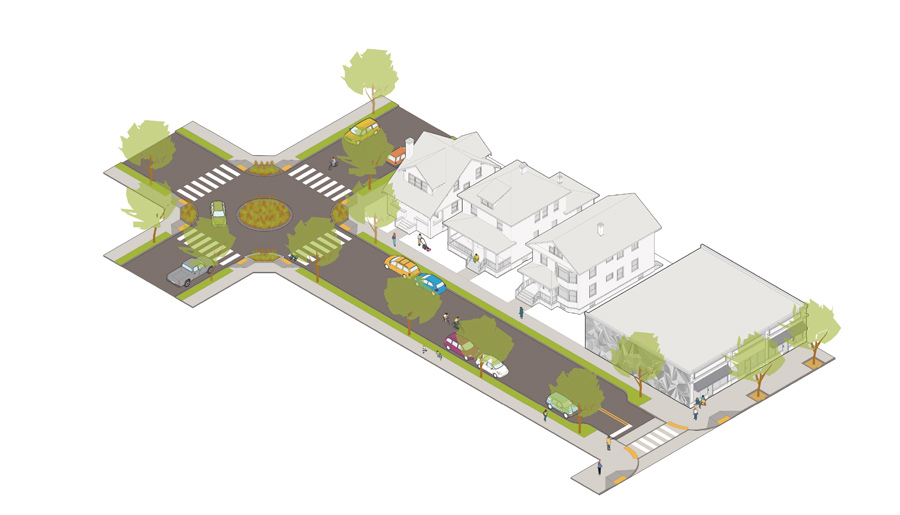Strategy 1 Develop a Street Design Guide that informs the planning and design of all future street projects.
The actions within this strategy are divided into two categories:
Action we will DOActions we will SUPPORTAction we will do are followed by “DO” and are colored in dark gray, and actions we will support are followed by “SUPPORT” and are colored in light gray.
Learn more about how we get thereThe Street Design Guide will recognize streets as the city’s largest public space and institutionalize the City’s Complete Streets Policy, Vision Zero commitment, greenhouse gas emission reduction goal, commitment to racial justice and stormwater management requirements through the design of city right of way.
The City of Minneapolis has strong policies that direct resources and set an agenda relative to transportation. Key policies include:
- Complete Streets, which establishes a modal priority framework that prioritizes people as they walk, bicycle, and take transit over people when they drive;
- Vision Zero, which sets a goal of ending traffic related fatalities and life-changing injuries on our streets by 2027;
- Climate-related goal to reduce citywide greenhouse gas emissions by 30% by 2025 and 80% by 2050 (from 2006 emissions levels)
- Commitment to racial justice, detailed in the City's Strategic Racial Equity Action Plan, which seeks to dismantle institutional injustice and close racial disparities in health, housing, public safety and economic opportunities; and
- Stormwater management programs that increase pervious areas and incorporate stormwater quality practices into linear projects to improve the water quality in the city’s lakes, creeks and the Mississippi River.
These policies give clear direction for an approach to how we design our streets. Street design must reflect these policies and translate them into opportunities for increased health and safety outcomes for everyone and improved walking, biking, transit, and green infrastructure.
The Street Design Guide will:
- Directly support transportation goals and provide the starting point for all designs for street reconstruction projects in the city.
- Serve as a starting point for street design changes to better meet our goals and provide safer and more convenient options without waiting for a street reconstruction project, through projects that rely primarily on operational changes through street restriping and use of bollards.
- Inform approaches for all partnership projects on streets owned and operated by other jurisdictions.
Actions to develop a Street Design Guide that informs the planning and design of all future street projects.
Design 1.1
Establish an updated street typology based on planned land use and built form, including consideration of schools, parks and other destinations, to inform the character of streets and organize design guidance.
Supported goals:
Safety Mobility
Related actions:
Difficulty:
Low
Timeframe:
2020-2023 (Years 0-3)
Design 1.2
Create typical concepts and cross-sections for each street type based on common street widths, including designs for reconstruction, resurfacing, and other interim street projects.
Supported goals:
Safety
Related actions:
Difficulty:
Low
Timeframe:
2020-2023 (Years 0-3)
Design 1.3
Publish the Street Design Guide online in a user-friendly format on a platform that is accessible to City staff, partner agencies, private developers and the public.
Supported goals:
Safety Active Partnerships
Related actions:
Difficulty:
Low
Timeframe:
2020-2023 (Years 0-3)
Design 1.4
Update requirements for private development and utility work that impacts the street right of way to incorporate treatments detailed in the Street Design Guide.
Supported goals:
Safety Active Partnerships
Related actions:
Walking 7.1, Walking 7.2, Walking 7.3, Walking 7.4, Walking 7.5, Walking 7.6
Difficulty:
Low
Timeframe:
2020-2023 (Years 0-3)
Design 1.5
Update the Complete Streets checklist for transportation projects to align with the Street Design Guide.
Supported goals:
Safety
Related actions:
Difficulty:
Low
Timeframe:
2020-2023 (Years 0-3)
Design 1.6
Review the Street Design Guide every two years and make updates as needed to reflect changes in transportation options, local and national best practices and new information as a result of research and evaluation of pilot projects and data evaluation.
Supported goals:
Safety
Related actions:
Difficulty:
Low
Timeframe:
2020-2023 (Years 0-3)
Status:
On-going
Design 1.7
Research, evaluate and adopt design guidance for automated vehicles and automated transit curbside use needs and travel lane impacts.
Supported goals:
Safety Mobility Active Partnerships
Related actions:
Technology 1.5
Difficulty:
High
Timeframe:
2024-2027 (Years 4-7)

